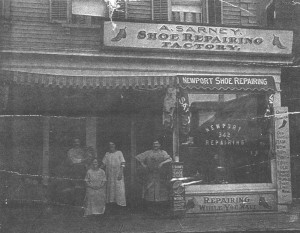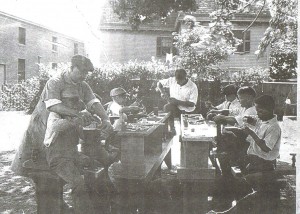David Allen Lambert’s April post on livelihoods inspired me to consider my own “family’s business.” In looking at my ancestry, one occupation pops up again and again and again: shoemaker. From Great Migration immigrants to Italian calzolai to French-Canadian shoe factory workers, my ancestors knew shoes.
The earliest shoemakers or cordwainers to New England arrived in 1629.[1] My ancestor (on my father’s side) Anthony Morse (abt. 1607–1686) arrived in Newbury aboard the James in 1635 with his brother William. Both appear on a passenger list as shoemakers.[2]
A few generations later, the family business was alive and well. By 1820, Samuel Morse (1772–1857) had moved his family up to the fledgling community of Industry, Maine. “Among the queer people of Industry in its early days was an itinerant shoemaker named Morse. This nomadic cordwainer used to travel through the town and work up the settler’s supply of leather into boots and shoes for the family.”[3] He returned to Massachusetts by 1845. While his “go at it” in Maine was short lived, he continued shoemaking until his death in 1857, passing on his skills to his son Thomas and his grandsons Colonius and James. Samuel’s work bench will be on display at the Georgetown (Massachusetts) Historical Society in the coming months.
The Civil War and the need for mass-produced footwear drastically changed the shoe industry – something my ancestors took in stride. Toussaint Legault (1843–1924) and Napoleon Sayers/Seguin (1867–1947), both French-Canadian immigrants, settled in Haverhill, Massachusetts, in the nineteenth century to work in the shoe factories. By 1913, nearly 10% of all shoes made in America came from Haverhill.[4]
On my mother’s side, the livelihood is the same, but the context a little different. Giuseppe Sarni was born in San Mango sul Calore (Avellino), Italy, in 1876 to a long line of calzolai (shoemakers), and would have started learning the trade while still a child. He emigrated to the U.S. sometime before 1906 and in 1911 is listed as a shoemaker in Boston. His older brother, Francescantonio, had emigrated in the 1890s and set up the Sarney Shoe Repairing Factory in Newport, Rhode Island.
It is interesting to think that my family’s past profession – representing hundreds of years and several locations and traditions – is now just that, a thing of the past. While I may not follow in my ancestors’ professional footsteps, I will say my love for shoes is undeniable. Hey, if the shoe fits!
Notes
To learn more, visit the Honourable Cordwainers’ Company website: http://www.thehcc.org/
For more on shoemakers in eighteenth-century America, listen to Colonial Williamsburg’s “Past & Present” podcast series: http://podcast.history.org/2012/03/26/meet-the-shoemaker/
[1] Honourable Cordwainers’ Company’s website, http://www.thehcc.org/, accessed 6 May 2015.
[2] Robert Charles Anderson, The Great Migration, Immigrants to New England, 1634-1635, Volume V, M-P (Boston: NEHGS, 2007), 159.
[3] William Collins Hatch, A History of the Town of Industry (Farmington, Me.: Knowlton, McLeary & Co., 1893), 271.
[4] http://www.haverhilltourism.com/history.html, accessed 7 May 2015.
Share this:
About Ginevra Morse
As Director of Education and Online Programs, Ginevra manages online learning opportunities that showcase NEHGS resources. She previously worked in educational publishing, where she also created webinars, and as Publications Coordinator for NEHGS. Ginevra holds a B.A. in anthropology from McGill University in Montréal.View all posts by Ginevra Morse →

